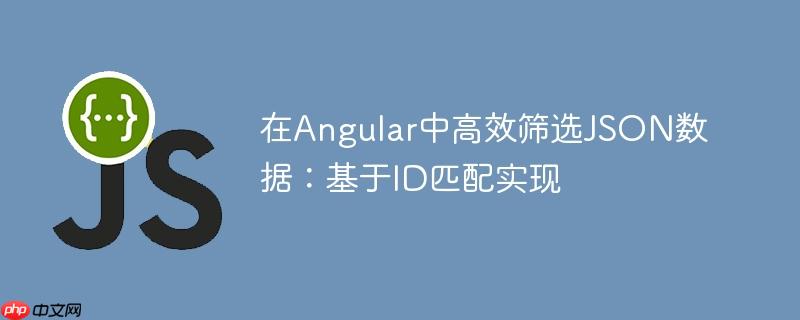
本文详细介绍了如何在angular(JavaScript环境)中,根据一个json数组中包含的ID列表,高效地从另一个包含完整记录的json数组中筛选出匹配的数据。核心解决方案是利用JavaScript原生的Array.prototype.Filter()和Array.prototype.some()方法,通过示例代码演示了如何实现精准的数据匹配与提取,并探讨了针对大规模数据集的性能优化策略。
数据筛选需求概述
在前端开发中,尤其是在angular应用中,我们经常会遇到需要对数据进行筛选的场景。一个常见的需求是:给定两个json数组,一个包含所有详细数据记录(例如,所有车辆信息),另一个只包含一组标识符(例如,需要显示的车辆id)。我们的目标是从第一个数组中,筛选出那些id存在于第二个数组中的记录。
假设我们有以下两个JavaScript数组(通常被称为JSON数据,但实际上是JavaScript对象数组):
数据源A (所有车辆记录):
[ { "id": 100, "brand": "Tes1", "vname": "Testname1" }, { "id": 200, "brand": "Tes2", "vname": "Testname2" }, { "id": 300, "brand": "Tes3", "vname": "Testname3" } ]
筛选条件B (目标ID列表):
[ { "id": 100 }, { "id": 300 } ]
我们期望的输出是:
[ { "id": 100, "brand": "Tes1", "vname": "Testname1" }, { "id": 300, "brand": "Tes3", "vname": "Testname3" } ]
核心解决方案:Array.prototype.filter() 与 Array.prototype.some()
JavaScript提供了强大的数组原型方法来处理这类数据操作。针对上述需求,Array.prototype.filter() 和 Array.prototype.some() 的组合是实现这一目标的优雅且高效的方法。
-
Array.prototype.filter(): 这个方法创建一个新数组,其中包含所有通过所提供函数实现的测试的元素。它会遍历原始数组的每个元素,并对每个元素执行一个回调函数。如果回调函数返回 true,则该元素会被包含在新数组中;如果返回 false,则会被排除。
-
Array.prototype.some(): 这个方法测试数组中的至少一个元素是否通过了由提供的函数实现的测试。它会遍历数组,一旦找到一个元素使得回调函数返回 true,some() 就会立即返回 true,并停止遍历。如果遍历完所有元素都没有找到满足条件的,则返回 false。
将这两个方法结合使用,我们可以这样理解:对于数据源A中的每一个车辆记录,我们使用filter()来决定它是否应该被保留。在filter()的回调函数内部,我们使用some()来检查当前车辆记录的id是否存在于筛选条件B的ID列表中。
实现示例
下面是具体的代码实现:
import { Component } from '@angular/core'; @Component({ selector: 'app-data-filter', template: ` <h3>筛选后的车辆数据:</h3> <pre>{{ filteredVehicles | json }}</pre> ` }) export class DataFilterComponent { // 原始车辆数据 (JSON A) allVehicles = [ { id: 100, brand: 'Tes1', vname: 'Testname1' }, { id: 200, brand: 'Tes2', vname: 'Testname2' }, { id: 300, brand: 'Tes3', vname: 'Testname3' }, { id: 400, brand: 'Tes4', vname: 'Testname4' } ]; // 需要匹配的ID列表 (JSON B) targetIds = [ { id: 100 }, { id: 300 } ]; // 存储筛选后的数据 filteredVehicles: any[]; constructor() { this.filteredVehicles = this.filterVehiclesByIds(this.allVehicles, this.targetIds); } /** * 根据ID列表筛选车辆数据 * @param vehicles 完整的车辆数据数组 * @param idsToMatch 包含要匹配ID的数组 * @returns 筛选后的车辆数据数组 */ filterVehiclesByIds(vehicles: any[], idsToMatch: any[]): any[] { // 使用 filter 方法遍历 allVehicles 数组 const result = vehicles.filter(vehicleA => { // 对于 allVehicles 中的每一个 vehicleA,检查它的 id 是否存在于 targetIds 中 return idsToMatch.some(idB => idB.id === vehicleA.id); }); return result; } }
代码解析:
- vehicles.filter(vehicleA => { … }): filter方法遍历allVehicles数组中的每一个vehicleA对象。
- idsToMatch.some(idB => idB.id === vehicleA.id): 这是filter方法内部的回调函数。对于当前的vehicleA,some方法会遍历idsToMatch数组中的每一个idB对象。
- idB.id === vehicleA.id: 这是some方法的条件。如果idsToMatch中存在任何一个idB的id与vehicleA的id相等,some方法就会立即返回true。
- 如果some返回true,则filter的回调函数也返回true,vehicleA就会被包含在最终的result数组中。反之,如果some遍历完idsToMatch都没有找到匹配的ID,则返回false,vehicleA会被排除。
性能考量与优化
上述方法对于中小型数据集非常有效且易于理解。然而,当targetIds数组非常庞大时(例如,包含数万个ID),Array.prototype.some()在filter的每次迭代中都需要遍历targetIds,这可能导致性能下降(时间复杂度接近O(N*M),其中N是vehicles的长度,M是idsToMatch的长度)。
为了优化这种情况,我们可以将targetIds转换成一个Set数据结构。Set允许我们存储唯一的值,并且其has()方法的查找时间复杂度平均为O(1)。
优化后的实现示例:
import { Component } from '@angular/core'; @Component({ selector: 'app-data-filter-optimized', template: ` <h3>优化筛选后的车辆数据:</h3> <pre>{{ optimizedFilteredVehicles | json }}</pre> ` }) export class DataFilterOptimizedComponent { allVehicles = [ { id: 100, brand: 'Tes1', vname: 'Testname1' }, { id: 200, brand: 'Tes2', vname: 'Testname2' }, { id: 300, brand: 'Tes3', vname: 'Testname3' }, { id: 400, brand: 'Tes4', vname: 'Testname4' } ]; targetIds = [ { id: 100 }, { id: 300 } ]; optimizedFilteredVehicles: any[]; constructor() { this.optimizedFilteredVehicles = this.filterVehiclesOptimized(this.allVehicles, this.targetIds); } /** * 优化后的根据ID列表筛选车辆数据 * 将ID列表转换为Set,提高查找效率 * @param vehicles 完整的车辆数据数组 * @param idsToMatch 包含要匹配ID的数组 * @returns 筛选后的车辆数据数组 */ filterVehiclesOptimized(vehicles: any[], idsToMatch: any[]): any[] { // 步骤1: 将 targetIds 转换为一个 Set,存储所有需要匹配的ID值 // 这样,后续的查找操作将具有接近 O(1) 的时间复杂度 const idSet = new Set(idsToMatch.map(item => item.id)); // 步骤2: 使用 filter 方法遍历 allVehicles 数组 const result = vehicles.filter(vehicleA => { // 对于 allVehicles 中的每一个 vehicleA,检查它的 id 是否存在于 idSet 中 return idSet.has(vehicleA.id); }); return result; } }
优化解析:
- const idSet = new Set(idsToMatch.map(item => item.id));: 在筛选之前,我们首先遍历idsToMatch数组,提取出所有ID值,并将其放入一个Set中。这个操作的时间复杂度是O(M)。
- idSet.has(vehicleA.id): 在filter的回调函数中,我们不再使用some()遍历数组,而是直接使用Set的has()方法来检查vehicleA.id是否存在于idSet中。Set.has()的平均时间复杂度是O(1)。
通过这种优化,整个筛选过程的时间复杂度降至O(N + M),对于大数据集而言,性能提升显著。
注意事项
-
数据结构一致性: 确保两个数组中用于匹配的键名(例如id)是相同的,并且其值类型也是一致的。
-
空数组处理: 如果targetIds为空,filter操作将返回一个空数组,这符合预期。
-
Angular上下文: 虽然示例代码是在Angular组件中提供的,但核心的JavaScript数组操作逻辑是通用的,可以在任何JavaScript环境中应用。
-
类型安全: 在typescript环境中,推荐为数据接口定义类型,以增强代码的可读性和健壮性。例如:
interface Vehicle { id: number; brand: string; vname: string; } interface TargetId { id: number; } // 使用类型 allVehicles: Vehicle[] = [...]; targetIds: TargetId[] = [...];
总结
在Angular及其他JavaScript应用中,根据一个数组的ID来筛选另一个数组的数据是一个常见的任务。Array.prototype.filter()结合Array.prototype.some()提供了一个简洁有效的解决方案。对于需要处理大规模数据集的场景,通过将筛选条件转换为Set数据结构,可以显著提升查找效率,优化应用程序的性能。理解这些核心的JavaScript数组操作方法,是编写高效、可维护前端代码的关键。


















